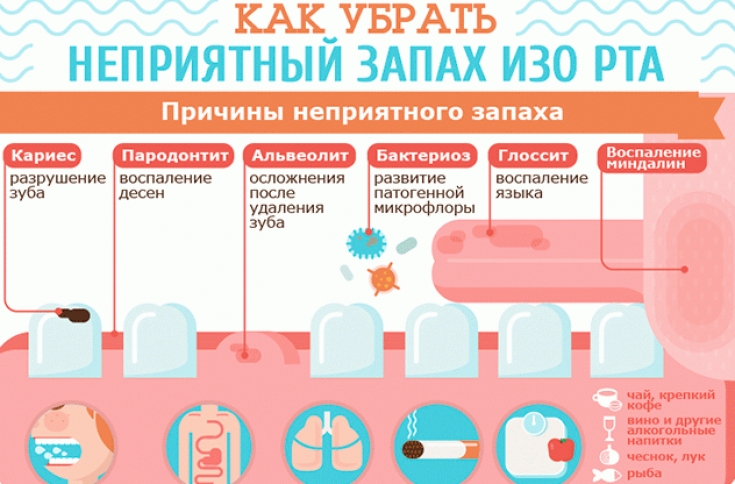Attractive appearance, great sense of humor and good manners instantly lose their value against the background of bad breath. Bad breath can become an obstacle in communicating with even the most charming person. Unfortunately, in most cases, patients rarely turn to professionals with complaints of bad breath.
On the other hand, dentists themselves often ignore the possibility of such a symptom being a reflection of somatic diseases. About the most common causes of bad breath, as well as modern approaches to eliminating this symptom, read on estet-portal.com in this article.
Causes of bad breath in patients
There are a wide variety of factors that can lead to bad breath in patients.
Bad breath can be the result of not only poor oral hygiene, but also a reflection of the patient's somatic diseases.
The causes of bad breath include conditions such as:
1. Poor oral hygiene, improper brushing technique;
2. The patient has caries, periodontitis;
3. Sjögren's Syndrome;
4. Decrease in salivation while taking anticholinergic drugs;
5. Smoking;
6. Alcohol abuse;
7. Chronic tonsillitis;
8. Maxillary sinusitis
9. Diverticulitis and achalasia of the esophagus, gastroesophageal reflux disease;
10. Bronchoectatic disease, lung empyema;
Thus, bad breath can be a symptom of damage to various organs and systems. However, in most cases, such patients turn to dentists. Despite the fact that poor hygiene and dental diseases are the causes of bad breath in 80% of cases, it is necessary to conduct a differential diagnosis with the above conditions.
Follow us on Telegram
But it is also worth remembering those situations when a patient complains of bad breath, but the doctor does not objectively determine it. In such cases, the clinician should think about the presence of true olfactory hallucinations in the patient, which may occur against the background of mental and neurological disorders.


Bad breath: eliminating decreased salivation
Elimination of bad breath occurs by appropriate treatment of the etiological cause of its occurrence.
If the doctor objectively notes that the patient has decreased salivation, he should be advised:
1. Use of artificial saliva;
2. Moisturizing the oral mucosa with a solution of lysozyme;
3. Carrying out physiotherapeutic measures, in particular, galvanization of the large salivary glands;
4. Using chewing gum.
Why stains appear on the teeth: the formation of enamel hypoplasia
The patient should also be advised to use toothpastes containing chlorhexidine, cetylpyridinium, or triclosan. Using them helps to reduce the number of bacteria that cause bad breath. It should be borne in mind that chlorhexidine can contribute to the staining of tooth enamel.

Removing Bad Breath: Teeth Cleansing Technique
The main cause of bad breath in patients in most cases is poor oral hygiene.
Bad breath is often caused by poor brushing technique.
Proper brushing technique includes the following aspects:
1. Setting the toothbrush should be done at an angle of 45 degrees to the surface of the teeth;
2. Cleaning of the tooth surface should be carried out by sweeping movements in the direction from bottom to top on the lower jaw and from top to bottom on the upper jaw;
3. First you need to clean the lower jaw, and then the upper;
4. First, you need to clean the vestibular surface of the teeth, and then the oral;
5. The lower molars should be cleaned first, with an average of up to 10 movements from each surface of two adjacent teeth;
What is the danger of oral fibroma
6. The surface of the brush should cover the maximum area of the teeth and penetrate into the interdental spaces;
7. When brushing your teeth, it is necessary to grab the edge of the gum, but do not injure it;
8. After cleaning the vestibular and oral sides of the upper and lower jaws, it is necessary to clean the chewing surface of the teeth;
9. Cleansing of the teeth is completed by making circular movements from their vestibular side. After brushing the teeth, it is necessary to clean the surface of the tongue with light movements of the brush.
Unfortunately, many patients spend no more than 30 seconds brushing their teeth. In such a short period of time, it is impossible to adequately clean their surface from pathogenic bacteria. The doctor needs to explain in detail the technique of cleaning the teeth to all patients who come with complaints of bad breath.
Thank you for staying with estet-portal.com. Read other interesting articles in the "Dentistry" section. You might also be interested in Stress or toothpaste: causes of painful mouth sores.







Add a comment